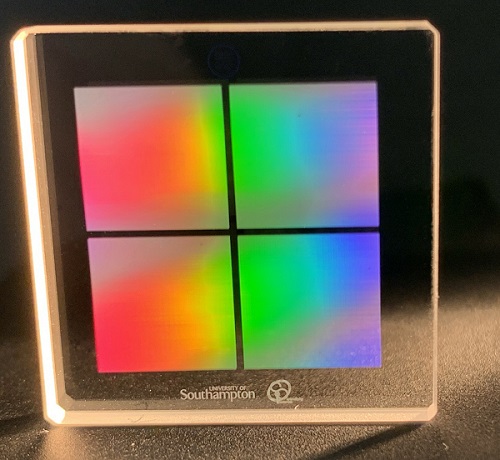University of Southampton researchers have developed a fast and energy-efficient laser-writing method for producing high-density nanostructures in silica glass. The resulting tiny structures can be used for long-term five-dimensional (5D) optical data storage that is more than 10,000× denser than Blu-ray optical disc storage technology.
“Individuals and organizations are generating ever-larger data sets, creating the desperate need for more efficient forms of data storage with a high-capacity, low energy consumption, and long lifetime,” said doctoral researcher Yuhao Lei of the University of Southampton. “While cloud-based systems are designed more for temporary data, we believe that 5D data storage in glass could be used for longer-term data storage for national archives, museums, libraries, or private organizations.”

Researchers at Southampton University developed a fast and energy-efficient laser-writing method to produce nanostructures in silica glass. They used the method to record 6 GB of data in a 1-in. silica glass sample. The four squares pictured each measure just 8.8 × 8.8 mm. The group also used the laser-writing method to write the university logo and mark on the glass. Courtesy of Yuhao Lei and Peter G. Kazansky, University of Southampton.
Five-dimensional optical data storage in transparent materials has been demonstrated before, though the ability to write data at speeds fast enough, and with a high enough density for real-world applications, has proved to be a challenge. To overcome the hurdle, the researchers used a femtosecond laser with a high repetition rate to create tiny pits containing a single nanolamella-like structure measuring just 500 × 50 nm each. The approach wrote at speeds of 1 million voxels per second, equivalent to recording about 230 kB of data (more than 100 pages of text) per second.
“The physical mechanism we use is generic,” Lei said. “We anticipate that this energy-efficient writing method could also be used for fast nanostructuring in transparent materials for applications in 3D integrated optics and microfluidics.”

Rather than using the femtosecond laser to write directly in the glass, the researchers harnessed the light to produce near-field enhancement, in which a nanolamella-like structure is created by a few weak light pulses, from an isotropic nanovoid generated by a single-pulse microexplosion. Using near-field enhancement to make the nanostructures minimized the thermal damage that has been problematic for other approaches that use high-repetition-rate lasers.
Because the nanostructures are anisotropic, they produce birefringence that can be characterized by the light’s slow axis orientation (fourth dimension, corresponding to the orientation of the nanolamella-like structure) and the strength of retardance (fifth dimension, defined by the size of nanostructure). As data is recorded into the glass, the slow axis orientation and strength of retardance can be controlled by the polarization and intensity of light, respectively.
“This new approach improves the data-writing speed to a practical level, so we can write tens of gigabytes of data in a reasonable time,” Lei said. “The highly localized, precision nanostructures enable a higher data capacity because more voxels can be written in a unit volume. In addition, using pulsed light reduces the energy needed for writing.”
The team used the method to write 5 GB of text data onto a silica glass disc about the size of a conventional compact disk with nearly 100% readout accuracy. Each voxel contained four bits of information, and every two voxels corresponded to a text character. With the writing density available from the method, the disc would be able to hold 500 TB of data.
With upgrades to the system that allow parallel writing, the researchers say it should be feasible to write this amount of data in about 60 days.
“With the current system, we have the ability to preserve terabytes of data, which could be used, for example, to preserve information from a person’s DNA,” said Peter Kazansky, leader of the research team.
The team aims to increase the writing speed and make the technology usable outside of a laboratory context. Faster methods for reading the data must also be developed for practical data storage applications.
The research was published in Optica (www.doi.org/10.1364/OPTICA.433765).